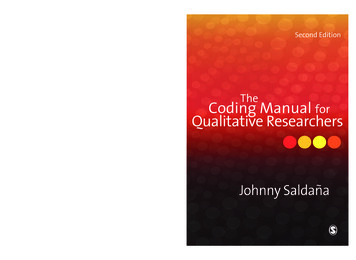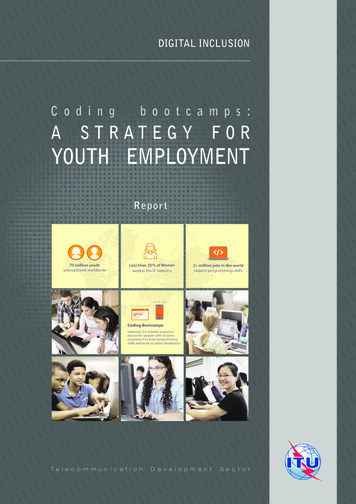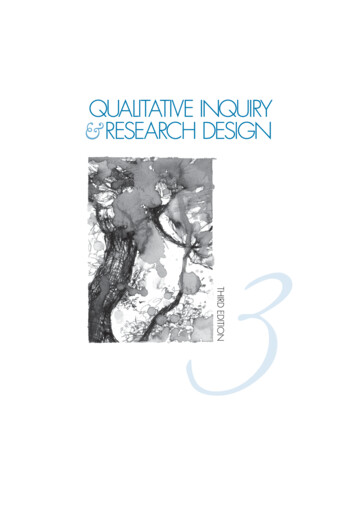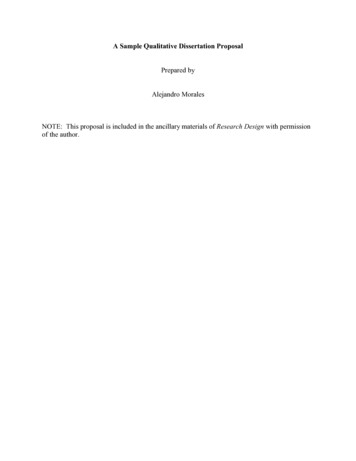
Transcription
2EMark Winton, Criminal Justice Instructor, University of Central Florida‘An excellent handbook that helps demystify the coding process with a comprehensive assessment ofdifferent coding types, examples and exercises. As such it is a valuable teaching resource and it will alsobe of use to anyone undertaking qualitative analysis.’Kevin Meethan, Associate Professor in Sociology, Plymouth University‘The Coding Manual describes the qualitative coding process with clarity and expertise. Its wide array ofstrategies, from the more straightforward to the more complex, are skillfully explained and exemplified.This extremely usable manual is a must-have resource for qualitative researchers at all levels.’Tara M. Brown, Assistant Professor of Education, Brandeis UniversityThe second edition of Johnny Saldaña’s international bestseller provides an in-depth guide to themultiple approaches available for coding qualitative data.Fully up-to-date, it includes new chapters, more coding techniques and an additional glossary. Clear,practical and authoritative, the book: Describes how coding initiates qualitative data analysisDemonstrates the writing of analytic memosDiscusses available analytic softwareSuggests how best to use The Coding Manual for Qualitative Researchers for particular studiesThe Coding Manual for Qualitative Researchers‘This book fills a major gap in qualitative research methods courses. Saldaña has accomplished what hasnot been done before - creating a text that clearly identifies the many choices one has in coding their data.I wish I had this book when I started conducting qualitative research. It should be required reading for all.’In total, 32 coding methods are profiled that can be applied to a range of research genres from groundedtheory to phenomenology to narrative inquiry. For each approach, Saldaña discusses the method’sorigins, a description of the method, practical applications and a clearly illustrated example withanalytic follow-up.Johnny Saldaña is a Professor of Theatre at Arizona State University.saldana coding 2e aw.indd 1-3SaldañaA unique and invaluable reference for students, teachers and practitioners of qualitative inquiry, thisbook is essential reading across the social sciences.Second EditionTheCoding Manual forQualitative ResearchersJohnny Saldaña20/09/2012 11:38
00-Saldana-Prelims.indd 131/07/2012 7:05:03 PM
SAGE has been part of the global academic communitysince 1965, supporting high quality research and learningthat transforms society and our understanding of individuals,groups and cultures. SAGE is the independent, innovative,natural home for authors, editors and societies who shareour commitment and passion for the social sciences.Find out more at: www.sagepublications.com00-Saldana-Prelims.indd 231/07/2012 7:05:03 PM
00-Saldana-Prelims.indd 331/07/2012 7:05:06 PM
SAGE Publications Ltd1 Oliver’s Yard55 City RoadLondon EC1Y 1SPSAGE Publications Inc.2455 Teller RoadThousand Oaks, California 91320SAGE Publications India Pvt LtdB 1/I 1 Mohan Cooperative Industrial AreaMathura RoadNew Delhi 110 044SAGE Publications Asia-Pacific Pte Ltd3 Church Street#10-04 Samsung HubSingapore 049483Editor: Jai SeamanEditorial assistant: Anna HorvaiProduction editor: Rachel EleyCopyeditor: Neville HankinsProofreader: Derek MarkhamMarketing manager: Ben SherwoodCover design: Jennifer CrispTypeset by: C&M Digitals (P) Ltd, Chennai, IndiaPrinted by: MPG Books Group, Bodmin,Cornwall Johnny Saldaña 2013First edition published 2009Reprinted 2009, 2010 (three times), 2011 (twice), 2012 (twice)This second edition published 2013Apart from any fair dealing for the purposes of research orprivate study, or criticism or review, as permitted under theCopyright, Designs and Patents Act, 1988, this publicationmay be reproduced, stored or transmitted in any form, or byany means, only with the prior permission in writing of thepublishers, or in the case of reprographic reproduction, inaccordance with the terms of licences issued by the CopyrightLicensing Agency. Enquiries concerning reproduction outsidethose terms should be sent to the publishers.Library of Congress Control Number: 2012932600British Library Cataloguing in Publication dataA catalogue record for this book is available fromthe British LibraryISBN 978-1-44624-736-5ISBN 978-1-44624-737-2 (pbk)00-Saldana-Prelims.indd 431/07/2012 7:05:06 PM
Abbreviated ContentsAbout the AuthorPreface to the Second EditionAcknowledgementsxvixviixxOneAn Introduction to Codes and Coding1TwoWriting Analytic Memos41ThreeFirst Cycle Coding Methods58FourAfter First Cycle Coding187FiveSecond Cycle Coding Methods207SixAfter Second Cycle Coding246Appendix A A Glossary of Coding Methods261Appendix B A Glossary of Analytic Recommendations269Appendix C Field Note, Interview Transcript,and Document Samples for Coding274Appendix D Exercises and Activities for Coding andQualitative Data Analytic Skill ims.indd 531/07/2012 7:05:06 PM
00-Saldana-Prelims.indd 631/07/2012 7:05:06 PM
ContentsAbout the AuthorPreface to the Second EditionAcknowledgementsxvixviixxOneAn Introduction to Codes and Coding1Chapter Summary 1Purposes of the Manual 1What Is a Code? 3Coding examples4Coding for patterns5Coding filters7Coding as a heuristic8Codifying and Categorizing 9From codes to categories9Recoding and recategorizing10From codes and categories to theory 12The differences between codes and themes 14What Gets Coded?15Units of social organization 15The coded researcher 16Amounts of data to code 16The Mechanics of Coding17Data layout 17Pre-coding19Preliminary jottings20Questions to consider as you code21Coding contrasting data22The Numbers of Codes 22“Lumping” and “splitting” the data 22The quantities of qualities24The codebook or code list24Manual and CAQDAS Coding 25Coding manually26Coding electronically28Data formatting for CAQDAS3000-Saldana-Prelims.indd 731/07/2012 7:05:06 PM
Coding capabilities with CAQDAS30Searches and queries with CAQDAS32Solo and Team Coding 34Coding collaboratively34Coding solo35Necessary Personal Attributes for Coding 36On Method 37Critiques against coding38Coding as craft40TwoWriting Analytic Memos 41Chapter Summary41The Purposes of Analytic Memo Writing41What is an Analytic Memo?41Examples of Analytic Memos 43Reflection and refraction50Coding and Categorizing Analytic Memos 50Analytic memos generate codes and categories51Grounded Theory and its Coding Canon 51Analytic Memos on Visual Data 52Documents and artifacts54Live and video recorded action55Recommended guidance56ThreeFirst Cycle Coding MethodsChapter SummaryThe Coding CyclesSelecting the Appropriate Coding Method(s)Various perspectives on coding decisionsResearch question alignmentParadigmatic, conceptual, and methodological considerationsCoding and a priori goalsCoding in mixed methods studiesExploratory coding“Generic” coding methodsNew and hybrid coding schemesGeneral criteria for coding decisionsOn overwhelming fearOverview of First Cycle Coding MethodsThe Coding Methods sisNotesviii00-Saldana-Prelims.indd 858585859606061626263646464666667676767686869THE CODING MANUAL FOR QUALITATIVE RESEARCHERS31/07/2012 7:05:07 PM
Grammatical MethodsAttribute isNotesMagnitude pleAnalysisNotesSimultaneous sNotesElemental MethodsStructural sNotesDescriptive sNotesIn Vivo ENTS00-Saldana-Prelims.indd 9ix31/07/2012 7:05:07 PM
Process sNotesInitial sNotesAffective MethodsEmotion sNotesValues sNotesVersus sNotesEvaluation CodingSourcesDescriptionx00-Saldana-Prelims.indd 5115115116116118119119119THE CODING MANUAL FOR QUALITATIVE RESEARCHERS31/07/2012 7:05:07 PM
ApplicationsExampleAnalysisNotesLiterary and Language MethodsDramaturgical sNotesMotif sNotesNarrative sNotesVerbal Exchange NotesExploratory MethodsHolistic NotesProvisional indd 1131/07/2012 7:05:07 PM
ExampleAnalysisNotesHypothesis sNotesProcedural MethodsProtocol sNotesOCM (Outline of Cultural Materials) sNotesDomain and Taxonomic sNotesCausation sNotesThemeing the ii00-Saldana-Prelims.indd 3163163165166169174175175175176177178THE CODING MANUAL FOR QUALITATIVE RESEARCHERS31/07/2012 7:05:07 PM
NotesMetasummary and metasynthesis181181FourAfter First Cycle CodingChapter SummaryPost-Coding TransitionsEclectic sDramaturgical code arrayAnalytic memoNotesCode Mapping and LandscapingCode mappingCode landscapingOperational Model DiagrammingAdditional Transition MethodsTabletop categoriesFrom codes to themes“Shop talking” through the studyTransitioning to Second Cycle Coding 99202204205205206206FiveSecond Cycle Coding MethodsChapter SummaryThe Goals of Second Cycle MethodsOverview of Second Cycle Coding MethodsSecond Cycle Coding MethodsPattern NotesFocused NotesAxial ms.indd 13xiii31/07/2012 7:05:07 PM
ical sNotesElaborative NotesLongitudinal 9229229231234234234234237238240242SixAfter Second Cycle CodingChapter SummaryPost-Coding and Pre-Writing TransitionsFocusing StrategiesThe “top 10” listThe study’s “trinity”CodeweavingThe “touch test”From Coding to TheorizingElements of a theoryCategories of categoriesCategories and analytic memos as sources for theoryFormatting MattersRich text emphasisHeadings and subheadingsFindings “at a glance”Writing About CodingOrdering and 53253254254256xiv00-Saldana-Prelims.indd 14THE CODING MANUAL FOR QUALITATIVE RESEARCHERS31/07/2012 7:05:07 PM
Analytic storyliningOne thing at a timeBegin with the conclusionAssistance from OthersPeer and online supportSearching for “buried treasure”Closure257257258258258259259Appendix A A Glossary of Coding MethodsAppendix B A Glossary of Analytic RecommendationsAppendix C Field Note, Interview Transcript,and Document Samples for CodingAppendix D Exercises and Activities for Coding andQualitative Data Analytic Skill aldana-Prelims.indd 15274279xv31/07/2012 7:05:07 PM
About the AuthorJohnny Saldaña received his BFA and MFA degrees in Drama Education fromthe University of Texas at Austin, and is a Professor of Theatre at Arizona StateUniversity’s (ASU’s) School of Theatre and Film in the Herberger Institute for Designand the Arts. He is the author of Longitudinal Qualitative Research: Analyzing Changethrough Time (AltaMira Press), Fundamentals of Qualitative Research (Oxford UniversityPress), Ethnotheatre: Research from Page to Stage (Left Coast Press), and the editor ofEthnodrama: An Anthology of Reality Theatre (AltaMira Press). The first edition of TheCoding Manual for Qualitative Researchers (Sage Publications) has been cited by scholarsand practitioners internationally in such fields as K–12 and higher education, humandevelopment, health care, social sciences, business, government, social services, technology, and the arts.Mr. Saldaña’s research in qualitative inquiry and performance ethnography hasreceived awards from the American Educational Research Association – QualitativeResearch Special Interest Group, the American Alliance for Theatre & Education,the National Communication Association – Ethnography Division, and the ASUHerberger Institute for Design and the Arts. He has published a wide range of researcharticles in such journals as Research in Drama Education, Multicultural Perspectives, YouthTheatre Journal, Journal of Curriculum and Pedagogy, Teaching Theatre, Research Studiesin Music Education, and Qualitative Inquiry, and has contributed several chapters toresearch methods handbooks.For e-mail correspondence, contact: Johnny.Saldana@asu.edu.00-Saldana-Prelims.indd 1631/07/2012 7:05:07 PM
Preface to the Second EditionThe second edition of The Coding Manual for Qualitative Researchers includes three newmethods profiles (Subcoding, Causation Coding, and Eclectic Coding); enhanceddiscussions in the Analysis sections; a new chapter that outlines analytic transitionprocesses between First and Second Cycles of coding; additional methods of qualitative data analysis and writing after Second Cycle coding; and a new glossary of the32 coding methods. References, CAQDAS profiles, and the section on analyzingvisual and mediated data have been updated. Emotion Coding’s example has beenchanged, and the criteria for selecting the most appropriate coding method(s) for astudy have been expanded. Many new figures have been added throughout the text.Google Scholar updates, conferences, and e-mail correspondence with studentsand colleagues over the past four years have informed me how the first edition ofThe Coding Manual for Qualitative Researchers has been utilized in a variety of studiesinternationally. Just a small sampling of topics addressed by scholars and practitioners include:K–12 Education children’s perceptions of climate changehigh school teachers’ perceptions of occupational professionalismhegemonic masculinity in Portuguese physical education classesschool reform in Swedenemotional and behavioral disability student mainstreaming in Hong KongHigher Education university faculty professional development assessmentBlack female and Latina careers in higher educationgraduate student teaching assistants’ encounters with student aggressioncollege leadership competenciespre-service teacher professional development in South Africa00-Saldana-Prelims.indd 1731/07/2012 7:05:07 PM
The Arts content analysis of music lyrics in Mexican narcocorridosdesigners’ and engineers’ thinking and decision-making processeslifelong outcomes of participation in high school speech and theatre programsart education for people with autismmusic therapy in African prisonsHuman Development gay and transgender identitiesadolescents’ perceptions of religion and spiritualitycivic engagement in young adultsinterpersonal dating and intimacy relationships among the elderlyretirement dilemmas of people with intellectual disabilities in AustraliaSocial Sciences juvenile correctional officers as advocatessociopolitical analysis of being “at risk”Latino youth perspectives on immigrationAfrican American Hurricane Katrina survivors and disaster resiliencereligious affiliation among CanadiansBusiness corporate social responsibility policiesfinancial crisis analysisEuropean retail barcode systemsproduct innovation teams in the Netherlandsorganizational change management and relocation in the UKTechnology global organization use of social networking sites virtual microscopy in human anatomy coursesxviii00-Saldana-Prelims.indd 18THE CODING MANUAL FOR QUALITATIVE RESEARCHERS31/07/2012 7:05:07 PM
electronic health record chart biopsies thematic synthesis in software engineering male resistance to women in technical workGovernment and Social Services humanitarian assistance disaster responseNASA telescope historythe Great Lakes Water Quality Agreement between Canada and the USAcounty administration in Swedennational forest policy in FinlandHealth Care self-concept and social functioning of women with breast cancerchildren’s perceptions of parental depressionrural southern African Americans with HIVrisk behaviors of Slovene injection drug usersgroup interpersonal psychotherapy in rural UgandaI am both humbled and honored that The Coding Manual for Qualitative Researchershas been referenced for these types of studies and many others worldwide. Graduatestudents and their professors have told me how much they appreciate the book’sclarity and mentorship tone for their professional development and projects. YetI must also extend my own thanks and gratitude to the legacy of scholars whose publications provide rich sources for several of the ideas collected in this manual. I giveextensive credit where credit is due by quoting, citing, and referencing their worksthrough fair use guidelines.My primary role as author of this book is to serve as a contemporary archivist ofthe vast literature on qualitative methods, and to selectively display and explain relevant material about codes and coding. But the amount of books and e-resources onthe subject has increased exponentially over the past decade, and I cannot possiblysurvey everything in the area. I must rely on you to bring your specific disciplinaryknowledge base and, of course, your rich personal experiences, to supplement thematerial included in this resource. I hope that the expanded second edition of TheCoding Manual for Qualitative Researchers offers readers even more pragmatic guidancefor qualitative data analysis.Johnny SaldañaArizona State UniversityPREFACE TO THE SECOND EDITION00-Saldana-Prelims.indd 19xix31/07/2012 7:05:08 PM
AcknowledgementsThanks are extended to:Patrick Brindle of SAGE Publications, London, who initially encouraged me to create thismanual.Anna Horvai, Jai Seaman, and Rachel Eley of SAGE Publications, London, and the anonymous manuscript reviewers for their pre-publication guidance throughout this project.My qualitative research instructors at Arizona State University: Tom Barone, Mary LeeSmith, Amira De la Garza, and Sarah J. Tracy, for introducing me to the methods andliterature of qualitative inquiry.Harry F. Wolcott, Norman K. Denzin, Yvonna S. Lincoln, Mitch Allen, Joe Norris, andLaura A. McCammon, for their inspiration, mentorship, and collegial support for myown research endeavors.Katie Desmond of QSR International Pty Ltd/NVivo, Ann Dupuis of ResearchWare,Inc./HyperRESEARCH, Normand Péladeau of Provalis Research/QDA Miner, ThomasRingmayr of ATLAS.ti, Julia Schehl of VERBI Software/MAXQDA, and David K. Woods ofTransana, for their assistance with CAQDAS screenshots and permissions.AltaMira Press, Elsevier, Oxford University Press, and Journal of Drug Issues for permissions to reprint extended excerpts from selected works.Lisa A. Kramer, Chiara M. Lovio, Laura A. McCammon, Teresa Minarsich, Angie Hinesand Matt Omasta for selected data contributions and analytic displays from fieldwork.Jonothan Neelands and Tony Goode for the formatting ideas.Jim Simpson for the “shop talk” and support.And all writers of references listed in this manual whose works, brought together in thiscollection, provide us with the right tools for the right job.00-Saldana-Prelims.indd 2008/08/2012 11:18:58 AM
I code, therefore I am.(Anonymous, written on a seminar room chalkboard)00-Saldana-Prelims.indd 2131/07/2012 7:05:08 PM
00-Saldana-Prelims.indd 2231/07/2012 7:05:08 PM
ONEAn Introduction to Codes and CodingCHAPTER SUMMARYThis chapter first presents the purposes and goals of The Coding Manual forQualitative Researchers. It then provides definitions and examples of codes and categories and their roles in qualitative data analysis. The procedures and mechanicsof coding follow, along with discussions of analytic software and team collaboration. The chapter concludes with reflections on necessary researcher attributes andthe role of method in coding.Purposes of the ManualThe three primary purposes of the manual are: to discuss the functions of codes, coding, and analytic memo writing during the qualitative data collection and analytic processes; to profile a selected yet diverse repertoire of coding methods generally applied in qualitative data analysis; and to provide readers with sources, descriptions, recommended applications, examples, andexercises for coding and further analyzing qualitative data.This manual does not address such matters as qualitative research design or how toconduct interviews or participant observation fieldwork. Those topics are alreadymasterfully discussed in other textbooks. The manual is intended as a reference tosupplement those existing works. It focuses exclusively on codes and coding andhow they play a role in the qualitative data analytic process. For newcomers toqualitative inquiry it presents a repertoire of coding methods in broad brushstrokes.Additional information and extended discussion of the methods can be found inmost of the cited sources. Grounded theory (discussed in Chapter Two), for example, is clearly profiled, streamlined, and re-envisioned in Kathy Charmaz’s (2006)Constructing Grounded Theory: A Practical Guide through Qualitative Analysis, whileGraham R. Gibbs’ (2007) Analysing Qualitative Data provides an elegant survey ofbasic analytic processes.01-Saldana-Ch-01.indd 131/07/2012 7:06:36 PM
The manual does not maintain allegiance to any one specific research genre ormethodology. Throughout this book you will read a breadth of perspectives oncodes and coding, sometimes purposely juxtaposed to illustrate and highlight thediverse opinions among scholars in the field. The following are just two examplesof such professional divergence:Any researcher who wishes to become proficient at doing qualitative analysismust learn to code well and easily. The excellence of the research rests in largepart on the excellence of the coding. (Strauss, 1987, p. 27)But the strongest objection to coding as a way to analyze qualitative researchinterviews is not philosophical but the fact that it does not and cannot work. Itis impossible in practice. (Packer, 2011, p. 80)No one, including myself, can claim final authority on coding’s utility or the“best” way to analyze qualitative data. In fact, there are a few instances where I takemoderate liberty with adapting and even renaming prescribed coding methods forclarity or flexibility’s sake. This is not intended to standardize terminology withinthe field, but simply to employ consistency throughout this particular manual.I must also emphasize at the very beginning that there are times when coding thedata is absolutely necessary, and times when it is most inappropriate for the study athand. All research questions, methodologies, conceptual frameworks, and fieldwork parameters are context specific. Also, whether you choose to code or notdepends on your individual value, attitude, and belief systems about qualitativeinquiry. For the record, here are mine, from Fundamentals of Qualitative Research:Qualitative research has evolved into a multidisciplinary enterprise, ranging fromsocial science to art form. Yet many instructors of research methods vary in theirallegiances, preferences, and prescriptions for how to conduct fieldwork andhow to write about it. I myself take a pragmatic stance toward human inquiryand leave myself open to choosing the right tool for the right job. Sometimes apoem says it best; sometimes a data matrix does. Sometimes words say it best;sometimes numbers do. The more well versed you are in the field’s eclectic methods of investigation, the better your ability to understand the diverse patternsand complex meanings of social life. (Saldaña, 2011b, pp. 177–8)Coding is just one way of analyzing qualitative data, not the way. Be cautious ofthose who demonize the method outright. And be equally cautious of those whoswear unyielding affinity to codes, or what has been colloquially labeled “codingfetishism.” I prefer that you yourself, rather than some presumptive theorist orhardcore methodologist, determine whether coding is appropriate for your particular research project.I also wrote this manual because I found it problematic (but not difficult) toteach coding in my own qualitative research methods course. I provided studentswith an array of readings about the process from multiple sources because I hadyet to find that single satisfactory book (to me) that focused exclusively on the201-Saldana-Ch-01.indd 2THE CODING MANUAL FOR QUALITATIVE RESEARCHERS31/07/2012 7:06:36 PM
topic. General introductory texts in qualitative inquiry are so numerous and wellwritten that it becomes difficult not to find the best one to use, but which one ofsuch quality works to select as the primary textbook. This manual supplementsintroductory works in the subject because most limit their discussions about coding to the writer’s prescribed, preferred, or signature methods. I wanted to providein a single resource a selected collection of various coding methods developed byother researchers (and myself) that provides students and colleagues with a usefulreference for classroom exercises and assignments, and for their own independentresearch for thesis and dissertation fieldwork and future qualitative studies. But byno means is it an exhaustive resource. I deliberately exclude such discipline-specificmethods as psychotherapy’s Narrative Processes Coding System (Angus, Levitt, &Hardtke, 1999), and such signature methods as the Davis Observation Code system for medical interviews (Zoppi & Epstein, 2002, p. 375). If you need additionalinformation and explanation about the coding methods, check the References.This manual is intended primarily as a reference work. It is not necessarily meantto be read cover to cover, but it certainly can be if you wish to acquaint yourselfwith all 32 coding methods profiles and their analytic possibilities. There are, in fact,several principles related to coding matters not discussed in the first two chaptersthat are unique to some of the profiles. If you choose to review all the contents,read selected sections at a time, not all of them in one sitting, otherwise it can overwhelm you. If you are scanning the manual to see which coding method(s) might beappropriate for your particular study, read the profiles’ Description and Applicationssections to see if further reading of the profile is merited, or check the glossary inAppendix A. It is doubtful you will use every coding method included in thismanual for your particular research endeavors throughout your career, but they areavailable here on an “as-needed” basis for your unique projects. Like an academiccurriculum, the sequential order of the profiles has been carefully considered. Theydo not necessarily progress in a linear manner from simple to complex, but are clustered generally from the fundamental to the intermediate to the advanced.What Is a Code?A code in qualitative inquiry is most often a word or short phrase that symbolically assigns a summative, salient, essence-capturing, and/or evocative attributefor a portion of language-based or visual data. The data can consist of interviewtranscripts, participant observation field notes, journals, documents, drawings,artifacts, photographs, video, Internet sites, e-mail correspondence, literature,and so on. The portion of data to be coded during First Cycle coding processescan range in magnitude from a single word to a full paragraph to an entire pageof text to a stream of moving images. In Second Cycle coding processes, the portions coded can be the exact same units, longer passages of text, analytic memosabout the data, and even a reconfiguration of the codes themselves developedthus far. Charmaz (2001) describes coding as the “critical link” between data collection and their explanation of meaning.AN INTRODUCTION TO CODES AND CODING01-Saldana-Ch-01.indd 3331/07/2012 7:06:36 PM
Do not confuse the use of code in qualitative data analysis with the use of codein the field of semiotics, even though there are some slight parallels between thetwo applications. In semiotics, a code relates to the interpretation of symbols intheir specific social and cultural contexts. In qualitative data analysis, a code isa researcher-generated construct that symbolizes and thus attributes interpretedmeaning to each individual datum for later purposes of pattern detection, categorization, theory building, and other analytic processes. Just as a title represents andcaptures a book, film, or poem’s primary content and essence, so does a code represent and capture a datum’s primary content and essence.Coding examplesAn example of a coded datum, as
The second edition of Johnny Saldaña’s international bestseller provides an in-depth guide to the multiple approaches available for coding qualitative data. Fully up-to-date, it includes new chapters, more coding tech










